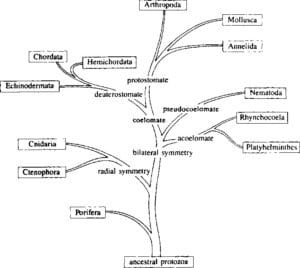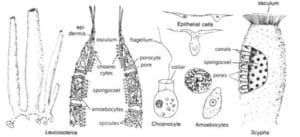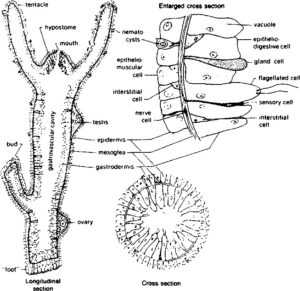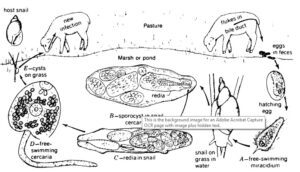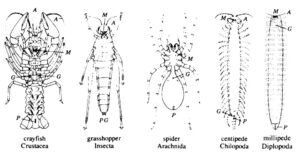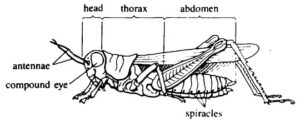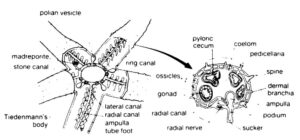Kingdom Animalia
 Kingdom Animalia Definition
Kingdom Animalia Definition
Kingdom Animalia is defined as animals that are multicellular, eukaryotic organisms that are characterized by their nutritional habits. Generally they eat (ingest) other living organisms.
Carnivore Animals
Many animals prey on other animals and are known as carnivores.
Example
A lioness stalks a herd of impala and kills one of the slower members of the herd. She shares the meal with other members of her group (pride). In this case the lioness is the predator (hunter), and the impala is the prey (the hunted). The remains may be picked on by such scavengers as vultures.
Herbivore Animals
Others ingest plants and are classified as herbivores.
Example
The impala graze on the grass, so they are herbivores.
Kingdom Animalia Classification
Kingdom Animalia Phylum
There are two major phyla.
- Vertebrata
Humans belong to a subphylum of the phylum Chordata known as Vertebrata. The vertebrates, or backboned animals, make up approximately 5 percent of the animal kingdom, but they figure prominently in the lives of humans.
- Invertebrates
All other animals are classified as invertebrates.
Subkingdom Parazoa: The Sponges
The animal kingdom is usually subdivided into groupings designed to reflect the evolutionary relationships of major lineages (see Figure 1).
Phylum Porifera in Kingdom Animalia
The sponges are generally placed in a separate subkingdom known as Parazoa, while all other animals, supposedly derived from a separate protistan modification, form the subkingdom Eumetazoa.
Characteristics of Sponges
The sponges are sessile (permanently attached, hence nonmotile), sack like organisms belonging to the phylum Porifera. The name of the phylum is derived from the anatomy of the sponge.
Structure of Sponges
Many pores dot the surface of the sponge body. Water is sucked in through these pores, moves through the interior cavity (spongocoel) within the body of the sponge, and exits through an excurrent vent (osculum) (see Figure 2). Food particles in the water are filtered out by special cells, known as collar cells, or choanocytes.
Figure 2 The structure of sponges.
Although sponges are classified as multicellular animals, they demonstrate less integration and specialization of function than other animal groups. They lack tissue organization, and their cells are the primary units of structure and function. The body is two-layered—an outer epidermis and an inner sheet consisting mainly of choanocytes. A gelatinous compartment, the mesohyl, separates these layers.
Habitat of Sponges
Generally sponges are marine, but a few species inhabit fresh water. There are more than 10,000 species of sponges which vary greatly in size and shape. Some are brightly colored and enhance the appearance of marine bottoms. Aside from their use as effective cleansing swabs, sponges also produce antibiotics and a chemical that, when modified, is used in cancer chemotherapy. Sponges may be disaggregated by passing them through a mesh. The individual cells are then capable of reassociating to form an intact sponge. This is evidence of the autonomy the individual cells possess.
Spicules
Four classes exist within phylum Porifera. These classes are separated on the basis of such characteristics as the nature of the inorganic spicules (spinous support structures) deposited in the mesophyll.
Types of Sponges
The class Calcarea possesses a skeleton consisting of spicules of calcium carbonate.
- The Demospongiae,which make up more than 90 percent of all sponge species, usually contain silicon compounds in their spicules. Often these spicules also combine with spongin(tough collagen fibers).
- The glass sponges (Hexactinellida) are named for their six-rayed, siliceous (containing-silica), glasslike spicules.
- The Sclarospongiaecontain siliceous spicules above a dense network of calcium carbonate.
Radiata: Cnidaria and Ctenophora
Above the level of the sponges, animals can be broadly divided into two classifications on the basis of body symmetry.
- Radial symmetry
- Bilateral symmetry
The radially symmetrical phyla, the Radiata, possess a central mouth around which the rest of the organs are radially arranged.
Phylum of Radiata in Kingdom Animalia
The Radiata consist of two phyla.
- Cnidaria(coelenterates)
- Ctenophora (comb jellies)
Firstly Each of these phyla consists of individuals with two layers of cells, radial symmetry, and an inner gastrovascular cavity (coelenteron). The gastrovascular cavity serves as a digestive structure. Food is taken in through the mouth, and what is undigested passes out again through the mouth. Whereas sponges are filter feeders, the coelenterates and comb jellies can ingest large food particles and pass the digested nutrients throughout the body.
Level of Organization in Radiata of Kingdom Animalia
The Radiata display a tissue level of organization. Specialized nerve cells make up a nerve net, which may permeate the entire body of the organism. Polarity across nerve junctions, or synapses, is not apparent, since impulses appear to travel in either direction across the synapse. Epitheliomuscular cells make up a contractile tissue, which is actually derived from the outer (ectodermal) layer of cells.
Phylum Cnidaria in Kingdom Animalia
A striking feature of the cnidarians, giving the phylum its name, are the cnidocytes.
Characteristics of Cnidaria
These specialized cells in the tentacles and parts of the main body wall contain a coiled tube, the nematocyst, compressed within a capsule (see Figure 3). When appropriately stimulated, the cnidocyte “pops” the nematocyst, which may sting and lasso prospective prey. The nematocyst may also function as an anchoring device.
Classes of Cnidaria
The almost 10,000 species of Cnidaria are grouped into three major classes and one minor class.
- Hydrozoa (e.g., hydras)
- Scyphozoa (jellyfish)
- Anthozoa(corals and sea anemones)
Above are the major classes.
- the Cubozoa (sea wasps) the minor class.
Life Cycle of Hydra
In most hydrozoan life cycles a clear-cut polyp and medusa stage alternate (see Figure 4). In the scyphozoans, the medusa stage clearly predominates, the mesoglea (matrix between ectoderm and endoderm) is thick and occasionally cellular, and all live in the sea. The anthozoans (“flower animals”), the largest and most varied of the three classes of cnidarians, completely lack a medusa stage and consist of large, fleshy cylindrical bodies. They are responsible for the coral reefs found in warm ocean waters.
Corel Reef
Many coral reefs are built up of the hard limestone skeletons of anthozoans. These cnidarians usually form dense colonies, although a few exist as solitary organisms. All are polyps, although ancestral forms probably had a medusa stage. As each generation of these polyps dies, other polyps build a new layer of calcareous (calcium-containing) material on top of them. Often these skeletal remains are brilliantly colored and intricately patterned.
Formation of Corel Reef
In many coral formations the cnidarian skeletons merely form a framework. The bulk of the reef formation consists of other invertebrates that live and die within the limestone compartments of the reef. Of particular importance to the reef community are the algae (sources of food and producers of food) that permeate the tissues of the cnidarians and also live freely along the latticework of the reef.
Types of Corel Reef
Three major types of reef exist.
- Fringing reefs closely border a coastline.
- Barrier reefs are quite thick and are separated from the coast by a broad channel.
- Atollsare ring-shaped separate islands of coral, each surrounding a central lagoon.
Phylum Ctenophora in Kingdom Animalia
The ctenophores are similar to the cnidarians in terms of their radial symmetry and diploblastic (two-layered) body plan.
Characteristics of Ctenophora
However, they lack cnidocytes and do not demonstrate any alternation of body form (polyp to medusa) during their life cycle. The mesoglea may contain muscle cells that show independent properties of contractility. The phylum gets its name (Greek for “comb bearers”) from the eight rows of fused ciliary plates that run longitudinally along the body. The cilia in these plates (combs) beat synchronously to propel the animal in the water. Usually these sea walnuts (another common name) are passive passengers of ocean tides and stronger currents. Many of the species are luminescent, and all capture their food with the aid of sticky cells lining the tentacles.
Bilateria: Deuterostomes and Protostomes
All the remaining members of the animal kingdom probably arose from a common ancestral form that first demonstrated bilateral symmetry. This type of symmetry involves a similarity of morphology (shape and form) on each side of a longitudinal axis.
Characteristics of Bilateria
These Bilateria usually have a head, or anterior end, and a tail, or posterior end. The head end, which first enters a new environment, shows an increasing complexity of sensory structures in the more recently evolved groups. All the bilateral forms are triploblastic, possessing a third primary germ layer known as mesoderm. All the Eumetazoa above the level of Radiata are differentiated in terms of the presence or absence of a true coelom.
1. Acoelomates in Kingdom Animalia
The flatworms (Platyhelminthes) and proboscis worms (Rhynchocoela) have no coelom whatsoever. The digestive cavity, lined by the inner germ layer (endoderm), is the only body space. These two groups are known as acoelomates.
2. Pseudocoelomates
The pseudocoelomates have an unlined cavity between endoderm and mesoderm. These include such phyla as Rotifera and Nematoda (roundworms).
3. Coelomates
The coelomates possess a true coelom – a fluid-filled cavity within the mesoderm that is completely lined with epithelium. All the more complex animals beyond the roundworm level of organization possess a coelom. The coelomate Bilateria soon diverged into two major branches in the animal kingdom, based on differences in the developing embryo (see Figure 1).
1. Deuterostomes
In the deuterostomes (Greek for “second mouth”), the blastopore forms the anus, and the mouth is formed secondarily. Deuterostomes also demonstrate radial, indeterminate cleavage, whereas protostomes tend toward spiral, determinate cleavage. The major phyla showing deuterostome developmental patterns are Echinodermata and Chordata.
2. Protostomes in Kingdom Animalia
In the protostomes, the blastopore forms the mouth, and the anus is formed secondarily. the major protostome phyla are Platyhelminthes, Nematoda, Mollusca, Annelida, and Arthropoda.
Dissimilarities Between Deuterostomes and Protostomes
Deuterostomes and protostomes also differ in the origin of the mesoderm and in the formation of the coelom cavity.
- In deuterostomes, the mesoderm arises from endoderm in the archenteron. In protostomes, the mesoderm arises from a single cell determined early in development.
- Further, in deuterostomes, the coelom is formed from an out pocketing of the gut. As this bulge of mesodermal cells expands into the blastocoel and pinches off, it forms a separate “inner tube” of mesoderm, the hollow core of which is the coelomic cavity. In protostomes, the single mesodermal cell gives rise to a solid ring of cells around the gut. An internal split in this solid mass produces the coelom. Thus, These two methods of producing the coelom end in the same result.
Benefit of Coelom
The coelom endows an organism with several benefits. In separating the gut and other internal organs from the body wall, it permits independent movement of these two sectors of the body. Thus, peristaltic movements interior to the coelom need not interfere with the locomotor contractions of muscles in the body wall. The fluid of the coelom may also serve as a hydrostatic skeleton against which muscles in the body wall can contract to produce movement. Finally, the membranes of the coelom, such as the peritoneum, provide double-layered sheets of support for internal organs.
1. Acoelomates Phylum Platyhelminthes
The platyhelminths are the simplest of the triploblastic animals, but they exemplify an organ level of complexity compared with the tissue level shown by cnidarians and ctenophores. Their ancestral origin is not clear.
Classes of Phylum Platyhelminths
The almost 15,000 species are usually assigned to four separate classes.
1. Class Turbellaria (Flatworms)
Turbellaria is the only class of free-living flatworms. The name comes from the turbulence created in their water habitat by their vigorously beating cilia. They feed on small, live organisms or may tackle larger dead animals. The digestive cavity is branched and extends throughout the body of the flatworm. Considerable storage of food occurs, so turbellarians can survive long periods of starvation. Circulation of gases and solutes is extremely limited.
Example
The planaria is a typical turbellarian. It lives in fresh water, although most of its “classmates” are marine. Since no circulatory system exists, planarias are relatively long and flat. This morphology allows most cells of the flatworm to maintain contact with the surroundings so that gas and solute exchanges can occur readily. Planarias move by both beating of cilia and undulation of the body to produce a gliding motion.
Note: The three other classes of platyhelminths are all parasitic.
2. Class Monogenea
The Monogenea tend to have simple stages in their life cycle. They are hermaphrodites, but only rarely do they fertilize themselves.
3. Class Trematoda (Fluke)
The Trematoda (flukes) are parasites of a high order of complexity. They may have as many as four intermediate hosts, usually at least one of which is a mollusk (see Figure 5).
Liver Fluke
The Chinese liver fluke, Clonorchis sinensis, is a major parasite in many Asian countries. Adult worms live in the liver and biliary canals of humans and other mammalian hosts. The many eggs pass out of the host and must be ingested by a specific freshwater snail. After undergoing changes in form, the fluke, as an active swimming cercaria, burrows into a freshwater fish or crustacean, where it exists as a metacercaria. This second intermediate host, when eaten by a large carnivore, passes encysted metacercaria into the carnivore. The metacercaria become adult worms, thus completing the cycle.
Schistosome
More than 200 million Asians suffer from a blood fluke called a schistosome. The resulting parasitic disease (schistosomiasis) involves only two hosts, humans and snails. The effects of this parasitic disease are chronic fatigue, lowered resistance to other diseases, and a general malaise.
4. Class Cestoda (Tapeworm)
Tapeworms (Cestoda) are the fourth class of flatworm. They consist of an anterior head (scolex), which contains hooks or similar mooring devices to grip the interior of the intestine, where the worm passes most of its adult life. Behind the head lie repeating segments known as proglottids. Each proglottid contains male and female reproductive structures and little else, since the tapeworm has no digestive tract and little in the way of a nervous system. Tapeworms, long ribbons of proglottids, are eminently suited to a parasitic existence.
Phylum Rynchocoela of kingdom animalia
Members of phylum Rhynchocoela (the nemerteans) resemble the platyhelminths, but they possess an extensible proboscis (nose), which is used to capture prey, hence their name “proboscis worms.” In some cases, the proboscis has a stylet (small lance) at its tip, which acts as a needle for the injection of toxins. They are more complex than flatworms in that they possess an anus and a moderately well-developed circulatory system.
Pseudocoelomates: Rotifera and Nematoda
The Rotifera and Nematoda possess a pseudocoelom.
Phylum Rotifera
Characteristics of Rotifers in Kingdom Animalia
Rotifers are tiny and, despite their multicellularity, may be smaller than some large amoebas. Their name (“wheel carrier”) comes from the ridge of beating cilia (corona) that surrounds their mouth.
Importance of Rotifers
Rotifers are of particular interest to embryologists because all adults have a fixed number of cells, resulting from a constant number of zygotic cell divisions.
Reproduction in Rotifers of Kingdom Animalia
They also demonstrate many varieties of parthenogenesis in which unfertilized, but diploid, eggs routinely produce a new generation of young. In some cases, populations contain only females. Other groups produce haploid eggs that develop parthenogenetically into haploid males, a process resembling the situation in ants and bees. When sperm and egg unite to form a zygote, the fertilized egg is usually thick-shelled and highly resistant to adverse environmental conditions. Rotifers living in drainage pipes or mudholes may, when their environment dries out, change to a desiccated, long-enduring, inactive state and resume activity even years later when water becomes available.
Another Phylum
Several other phyla of tiny pseudocoelomates exist. They include the hermaphroditic Gaslrolricha and the spiny Kinorhyncha, which are virtually trapped within an external layer of cuticle.
Phylum Nematodes in Kingdom Animalia
Nematodes (roundworms) are the most numerous of all phyla in terms of actual numbers of individuals. Most of these worms, with their characteristic tapered ends, are free-living; however, such diseases as hookworm, trichinosis, and elephantiasis arise from parasitic roundworms.
Protostome Coelomates
Annelida, Mollusca, and Arthropoda are the three major protostome phyla that probably share a common evolutionary divergence. Arthropods and most of the mollusks have an open circulatory system in which large spaces (hemocoels) stand between arteries and veins. Annelids possess a closed circulatory system in which enclosed vessels (arteries, capillaries, and veins) ramify throughout the transport system. All three phyla are coelomates.
1. Phylum Annelida
The phylum Annelida (Latin for “ringed”) comprises worms whose bodies are divided into segments (metameres). This segmentation is clear externally but also exists internally in the form of membranes (septa) that subdivide the interior of the worm. Metamerism also exists in arthropods, believed to be directly related to the annelids, and in chordates as well.
Example
In the earthworm, a typical terrestrial annelid, the entire body is subdivided into segments that are generally similar to one another. Each segment contains four pairs of external bristles, which are used to anchor and move the worm. The segmentation is expressed internally in the existence of nephridial (excretory) tubes and excretory pores in almost all segments. However, the digestive tract is not segmented.
Classes of Phylum Annelids
Approximately 12,000 species of annelids dwell in terrestrial, marine, and freshwater habitats. Three classes exist.
1. Class Polychaeta in Kingdom Animalia
Polychaeta (“numerous bristles”) are the bristle worms, usually found at the seashore. Separate sexes generally exist. Pairs of fleshy paddles (parapodia) jut out on each segment, supplying locomotion and respiratory surfaces.
2. Class Oligochaeta
Oligochaeta (“few bristles”) are predominantly terrestrial, but a few marine and freshwater forms exist. They are hermaphroditic, and generally a pair of worms copulate to produce a double fertilization event. They live in moist environments, since gas exchange across their body surface requires that the gases be dissolved. Earthworms (Lumbricus) are a principal example of the class.
3. Class Hirudinea
Hirudinea are the leeches—relatively small, flattened, tapered worms with a sucker at each end. Many are parasitic on invertebrates or vertebrates. They attach to live organisms with the front sucker and ingest blood and other bodily fluids. They are hermaphroditic.
2. Phylum Mollusca
The phylum Mollusca (“soft-bodied”) consists of seven different classes. A tremendous diversity of form and lifestyle characterizes these classes; most are shelled, but some have lost the calcareous shell in the course of their evolution. All classes except the Bivalvia (clams and oysters) possess an extensible, raspy tongue called a radula. Rows of strong teeth along this usually flattened structure serve as a hacksaw when the radula is extended and pulled back over a food-laden area. Since no other phylum possesses a radula, it clearly serves to establish a tie of common descent among the mollusks.
Classes of Phylum Mollusca
We will examine four of the seven extant classes.
1. Class Polyplacophora of kingdom animalia
The Polyplacophora, named for the many (actually eight) shells borne upon the dorsal surface, are represented by the chitons. Although chitons are a relatively small group of molluscans, they bear a marked resemblance to the hypothesized ancestral form of all mollusks. The three basic regions found in almost all mollusks are the flat, highly muscular foot, the shell, and the mantle, which encloses the internal organs dorsally and lies alongside the foot (see Figure 6). In shelled mollusks the mantle secretes the shell. In fact, The mantle cavity, which lies between the mantle and the foot, contains the gills, which are usually leaflike flaps extending from the foot.
2. Class Gastropoda
The Gastropoda are the snails, periwinkles, conchs, and slugs (nonshelled gastropods). They are the largest and most diverse group of mollusks, with more than 75,000 species. The shells are often quite complex and even ornate, and the entire animal can usually retreat within the shell for protection.
3. Class Bivalvia of kingdom animalia
The Bivalvia include the mussels, scallops, clams, and oysters, which are major sources of fine seafood. They consist of two complementary shells, which are joined along the middle of the dorsal line of the body. Powerful muscles (adductors) pull the shells tightly together. When these muscles relax, the wedge-shaped foot can be extruded, and the bivalve may move about or grasp the substratum. Almost all bivalves are filter feeders, and they use the enlarged gills for both respiration and ingestion. The sexes are separate. Eggs are usually fertilized and may even develop through early stages within the tissues of the female.
4. Class Cephalopoda
The Cephalopoda are perhaps the most specialized and advanced of the mollusks. In almost all cases they lack a complete shell. The cephalopods have a highly developed nervous system and are capable, especially the squids, of very rapid locomotion. They are usually carnivores and possess many adaptations for hunting, including camera-type eyes capable of very fine resolution. They are unique among mollusks in having a closed circulatory system. Some giant squids weigh 500 kg.
Example
The chambered nautilus is the only extant cephalopod with a full shell. It resembles the squids and octopuses in basic body plan, but it occupies a very ornate striped shell. Most of the shell serves only to keep the entire animal afloat, and some zoologists feel that this is the route taken by other lineages of cephalopods in the evolutionary loss of the shell.
3. Phylum Arthropoda of kingdom animalia
In terms of numbers, diversity of species, and distribution in the biosphere, the Arthropoda are the most successful of all animal phyla. The five classes of arthropods (“jointed feet”) comprise well over a million species, and many new species continue to be discovered.
Characteristics of Phylum Arthropoda
Besides The body of an arthropod is usually covered by a thick, protective exoskeleton, the cuticle, which contains chitin. The body is usually segmented, as seen in annelids, with the segments giving rise to various types of appendages. Most arthropods have powerful compound eyes, which are composed of many tightly arrayed units known as ommatidia. Each unit has its own lens and retinal screen for the formation of an image. The coelom of arthropods is considerably reduced. This is also true for mollusks, however, most zoologists believe that arthropods are more closely related to the annelid worms than to mollusks.
Similarities Between Crustaceans and Insects
Among crustaceans and insects, the most anterior appendages become antennae (flexible sensory hairs) followed by laterally moving jaws (mandibles). These groups are classified as mandibulates. In arachnids and horseshoe crabs no antennae or mandibles develop. Instead, the most anterior pair of appendages form fleshy pincers known as chelicerae. These arthropods are known as chelicerates, they have four pairs of legs.
Classes of Phylum Arthropoda
There are five major classes of arthropods.
1. Class Arachnida of kingdom animalia
Arachnida includes spiders, mites, ticks, scorpions, and daddy longlegs (see Figure 7). All have four pairs of legs. Since they are largely terrestrial, they respire by means of tracheae or delicate internal leaflike plates known as book lungs. Some poison their prey. The spiders spin webs to ensnare unwary victims. Web building is species-specific and apparently controlled genetically.
2. Class Crustacea of kingdom animalia
Crustacea, primarily marine or aquatic forms, utilizes gills for respiration. It includes lobsters, shrimps, crabs, and barnacles; all have two pairs of antennae (sensory probes) on their heads. The second pair of antennae may serve in defense or even to obtain food in some crustaceans. Large crustaceans such as lobsters and shrimp are known as decapods. Smaller crustaceans make up the isopods, and the very tiny copepods are found as part of the plankton communities of oceans and lakes.
3. Class Diplopoda
The Diplopoda consists largely of the clearly segmented millipedes. They are herbivores and are almost entirely terrestrial. Each body segment has two pairs of legs, thus providing a great deal of support.
4. Class Chilopoda
The class Chilopoda contains the centipedes. They are all carnivores and are particularly adept at rapid running. They are, however, highly vulnerable to drying out. Both chilopods and diplopods are part of the superclass Myriopoda.
5. Class Insecta of kingdom animalia
The class Insecta has more species than all other animal organisms combined. Though rare in the sea, they are the most successful invaders of the terrestrial environment. They also abound in aquatic regions and in the air. The more than 25 orders of insects probably owe their adaptiveness to relatively small size, the existence of wings, a very acute compound eye, the existence of metamorphosis, and in some cases an elaborate social system.
Characteristics of Class Insecta
The body of most insects is patently divided, like Gaul, into three parts—a head, thorax, and abdomen (see Figure 8). The head is particularly complex, consisting of many individual parts that are elegantly integrated into sensory and mechanical devices. The sexes are separate, and fertilization almost always occurs during copulation, the insertion of the male penis into the vagina of the female. Insects are valuable pollinators of plants, but they also destroy crops and may be involved in the spread of disease. Biologists specializing in the study of insects are known as entomologists.
DEUTEROSTOME COELOMATES
Chordata and Echinodermata are the two major phyla of the deuterostome group. They both possess coeloms.
1. Phylum Echinodermata in Kingdom Animalia
The adult echinoderms generally demonstrate secondary radial symmetry. But the embryos, or larval forms in those groups that undergo metamorphosis, are similar to the chordates, which are bilaterally symmetrical. Six classes of echinoderms exist.
Structure of Echinoderms
Generally All are marine and share a common basic structure (see Figure 9).Five radiating arms usually circle a central disk. A system of tube feet extends from radial canals in each arm. A ring canal in the disk is the hub of this closed water-vascular system. This system functions in locomotion, excretion, and respiration.
2. Phylum Chordata of kingdom animalia
The nonvertebrate Chordata consists of two subphyla. The Urochordata (tunicates), which inhabit a benthic (ocean bottom) habitat, and the Cephalochordata (e.g., lancelet). They share, with the vertebrates.
Characteristics of Phylum Chordata
The three basic characteristics of all chordates.
- A notochord,a flexible but sturdy rod of fibrous tissue just ventral to the neural tube.
- A hollow dorsal nerve cordderived from ectoderm.
- Pharyngeal gill slits.
Subphylum Vertebrata of kingdom animalia
The specific features of the subphylum Vertebrata are a skeletal backbone and cranium, which encloses the spinal cord and brain. A high degree of cephalization (the specialization of the anterior end of the nervous system into a complex brain with associated specialized sense organs). Besides Segmentation of the muscles of the trunk into somites at some time in the course of development.
Classes of Vertebrata
Of the seven living classes of vertebrates, three are fishes. The remaining four classes are grouped as tetrapods (Greek for “four feet”) because they usually possess two pairs of limbs.
1. Class Agnatha
The Agnatha are jawless fishes that were once numerous but now consist only of hagfish and lampreys. A large proportion of present-day agnathans prey on other fish by attaching to their outer surface and boring through to the internal organs with their jagged tongue.
2. Class Chondrichthyes in Kingdom Animalia
The Chondrichthyes, like the agnathans, have skeletons made of cartilage. Both groups probably evolved from bony ancestors. Extant Chondrichthyes include sharks, rays, and skates. Though composed of cartilage, the jaws of the shark are a fearsome sight.
3. Class Osteichthyes
The Osteichthyes are the bony fish, which are found in both fresh and salt water.
Example
The seven species of salmon are among the most popular food and sport fishes, with the large sockeye salmon being the most extensively sought. Salmon are usually born in fresh water, with parents preferring a fast-moving stream. Fertilization during spawning (reproductive activity) occurs externally, with a male placing its sperm over eggs the female has deposited in “nests” in the shallow stream bottom. After a varying period of time the young salmon swim to the ocean, with only a few surviving the perilous trip. They usually return to the same stream to spawn after spending a few years or less in the ocean. Many species die shortly after spawning.
4. Class Amphibia of kingdom animalia
Amphibia, the frogs, toads, and salamanders, are only partially successful as terrestrial inhabitants. Many amphibians (a word meaning “both lives,” i.e., water and land) are dependent on water for their sexual activity. In frogs, the fishlike tadpole (larval form) undergoes metamorphosis to become a lung-bearing adult land dweller. Many amphibians, however, respire principally through a moist surface membrane rather than through their lungs.
5. Class Reptilia
The Reptilia all have scales on a rough, waterproof integument that shields against drying out. Other modifications for successful terrestrial life include functional lungs. An enclosed (cleidoic) egg in which the embryo can absorb yolk and develop Along with in a protective bath of amniotic fluid, well protected by a leathery shell, internal fertilization.Moreover A variety of behavioral patterns that enable the reptile to survive extremes of temperature and shortages of food.
Catastrophic Event in Mesozoic Era
During the Mesozoic Era, which ended about 65 million years ago, reptiles were the dominant land forms. Many of these reptiles were dinosaurs (Greek for “terrible lizard”) of rather awesome proportions. The more than 20 orders of reptiles that lived long ago have dwindled to a mere four or five orders today—lizards, snakes, alligators and crocodiles, and turtles and tortoises.
6. Class Aves in Kingdom Animalia
Birds have been aptly described as “flying lizards” by aves.” In addition to the fact that they probably descended from dinosaurs, they possess several features in common with reptiles. Birds and reptiles are characterized by a scaly skin, most notably visible on the unfeathered legs of birds. The telolecithal eggs are very similar, except that birds produce a brittle, rather than a leathery, shell. Production of a similar nitrogen end product (uric acid) is a biochemical clue to the relationship of the two classes.
Flying Capability of Birds
The birds have become exquisitely modified for flight. The skeleton is quite light, and many of the bones are hollow. Heavy reptilian teeth are replaced by a tough, but lighter, beak. The feathers, which probably evolved from reptilian scales, provide an ideal surface for flight. The four-chambered heart and the endothermic lifestyle support the extreme physical effort required for flight.
7. Class Mammalia of kingdom animalia
The class Mammalia shares with the insects an extreme mastery of the terrestrial habitat. Mammals have hair (fur), which affords an efficient mechanism for insulation, especially when piloerection (erection of hairs) increases the thickness of the insulating layer. The mammalian heart has four chambers. A diaphragm is present to enhance the efficiency of the lungs. Endothermy is always maintained. The salient characteristic of all mammals is the ability of the mother to produce nourishing milk for the young in mammary glands. The very primitive mammals known as monotremes do not have nipples or breasts, but they do produce milk, which runs down the ventral hairy surface and is lapped up by the young. Most mammals possess very complex brains and show highly sophisticated behavior patterns, including play.
Subclasses of Class Mammalia
There are three subclasses of Mammalia.
1. Prolheria in Kingdom Animalia
The monotremes (Protheria), like the duck-billed platypus and the spiny anteaters (echidnas) living in Australia, are rather avian in character. They lay eggs, lack teeth, and possess a beak. Their young hatch from eggs at a comparatively early stage and cling to the hair of the mother.
2. Metatheria of kingdom animalia
The mammalian subclass Metatheria consists of the marsupials, or pouched animals. hey dominate mammals in Australia, but in the United States, the opossum largely represents them. They are mammalian in their possession of teeth rather than a beak, and they give birth to live young. But the young are born at an early stage in their development and complete their fetal life within a pouch on the underside of the female body. Each of the young fastens on to a teat and feeding goes on continuously.
3. Eutheria in Kingdom Animalia
The Eutheria are the “true,” or placental, mammals, the most familiar mammalian representative of the northern hemisphere. They are distinguished, especially in larger organisms, by a protracted period of pregnancy during which the young reach a more advanced state of development than is the case for monotremes and marsupials. A placenta forms within the uterus, which is a major metabolic depot for exchange of food, oxygen, and waste between mother and fetus.
Example
Whales, dolphins, and porpoises make up the order Cetacea. Their bodies are streamlined for swimming in the oceans, and a thick layer of blubber (fat) protects them against the cold waters. Their forelimbs function like oars, secondly their hind limbs have been lost completely. Like other Eutheria they give birth to their young and nurse them through their early development.
Orders of Class Mammalia
Approximately 12 major orders of placental mammals exist, some of which have secondarily returned to oceans and lakes.
1. Order Carnivora in Kingdom Animalia
Carnivora is a particularly varied mammalian order, ranging from dogs, wolves, and large cats to otters and seals. Almost all carnivores are efficient predators, exemplifying Tennyson’s notion of a “nature red in tooth and claw.”
2. Order Rodentia
Rodentia, the order that includes squirrels, beavers, rats, and mice, is another widely dispersed group. Rats, in particular, are generally present in all urban areas and share the spoils created by humankind.
3. Order Chiroptera
Bats are found in the order Chiroptera. Much of the folklore dealing with the harm that they cause is generally false.
4. Order Artiodactyla
Sheep and cattle, with an even number of toes on each foot, belong to the Artiodactyla.
5. Order Perissodactyla in Kingdom Animalia
While horses, zebras, and rhinoceroses are part of the Perissodactyla, with an odd number of toes. Both these herbivorous orders contain species that live in close relationships with humans.




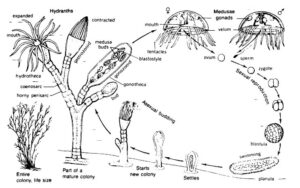 Kingdom Animalia Definition
Kingdom Animalia Definition